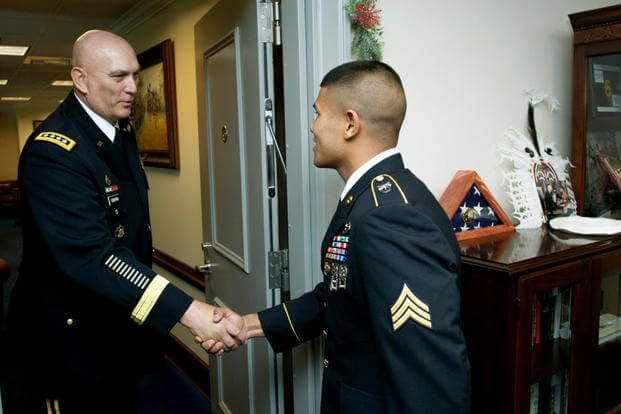1. MILITARY RECRUITS WAITING IN LIMBO
They have skills the military wants and needs. Why can't they ship to training?
Military.com reporter Richard Sisk takes a deeper look at the fate of the Military Accessions Vital To National Interest, or MAVNI program, and why an estimated more than 1,000 talented non-citizen MAVNI recruits have been stuck waiting months or years for paperwork and clearances to process before they can begin their military careers.
Some fear their visas will expire while they wait.
Sisk writes that the program, begun to attract non-citizen recruits with highly sought skill sets to serve in return for a track to citizenship, has effectively been suspended amid political immigration fights and concerns over security.
He talks to multiple MAVNI enlistees who are stuck waiting for approval, as well as former Army lieutenant colonel Margaret Stock, an attorney who helped to create MAVNI in 2008.
To meet a range of emerging threats, "we need these people," Stock said. "What we don't need is people sitting on a base for 18 months doing nothing because of background checks."
2. US STRIKES SYRIA TWICE AS HARD AS LAST TIME
Ships, subs and B-1s. A three-country coalition. Three chemical weapons sites taken out.
In response to a second chemical attack on civilians in Syria that appears to trace back to the regime of dictator Bashar Al-Assad, the U.S. military, in collaboration with the United Kingdom and France, sent a stern military message late Friday night.
In all, 105 weapons were deployed, including Tomahawk Land Attack Missiles and Joint Air to Surface Stand-Off Missiles-Extended Range. For the latter, it was the first time the upgraded weapon had been deployed in combat.
Targeted were the Barzah Research and Development Center near Damascus; the Him Shinsar chemical weapons storage facility near Homs; and the Him Shinsar bunker.
All the missiles hit their targets, officials said.
"These strikes were a justified, legitimate and proportionate response to the Syrian regime's continued use of chemical weapons on its own people," Pentagon spokeswoman Dana White said. "We will not stand by passively while Assad, backed by Russia and Iran, ignores international law."
The strike came roughly a year after the U.S. deployed 59 Tomahawks into a Syrian airfield in response to a previous deadly chemical attack last April.
3. … AND RUSSIA RESPONDS
"Russian President Vladimir Putin denounced the Friday night airstrike against Syria as aggression that will make the humanitarian crisis in that country worse, and called for an emergency meeting of the United Nations' Security Council.
Putin added that the strike had a 'destructive influence on the entire system of international relations.'
The United States, France and Britain launched military strikes in Syria to punish President Bashar Assad for an apparent chemical attack against civilians and to deter him from doing it again, U.S. officials said.
Pentagon officials said the attacks targeted the heart of Assad's programs to develop and produce chemical weapons.
Syrian television reported that Syria's air defenses, which are substantial, responded to the attack. Defense Secretary Jim Mattis said there were no reports of U.S. losses in what he described as a heavy but carefully limited assault."
4. PILOTS TO BLAME IN A-10 CRASH
From Military.com’s Oriana Pawlyk
"Two A-10C Thunderbolt IIs collided last year over the Nevada desert due to insufficient communication over altitude, according to a newly released investigation report.
During a night close air support training mission in the Nevada Test and Training Range on Sept. 6, the first mishap pilot, called 'Pilot One' in the investigation, did not hear he had climbed too high above his assigned ‘altitude block,’ entering space that was designated for 'Pilot Two,' according to the Accident Investigation Board report published by Air Combat Command on Thursday.
'Pilot One climbed above the assigned altitude block during a series of commands and did not hear the audible notification signaling the altitude climb and therefore did not radio-in to deconflict established altitude blocks,' ACC said in a release.
Pilot Two 'did not have line of sight on [Pilot One] when the collision occurred. The midair collision rendered both aircraft uncontrollable and both pilots ejected,' the release said.
The crash occurred roughly 50 miles away from Nellis Air Force Base."
Both pilots have resumed flying for the air force, officials said.
5. WWII HERO’S LOVE STORY
Military.com's Richard Sisk has an interview with 88-year-old Pauline Conner, widow of former Army 1st Lt. Garlin Murl Conner, who is set to posthumously receive the Medal of Honor later this year:
"She would learn the things that Conner had done to earn the respect of the county, but not from him.
'It was always other people. He didn't want to say much, didn't want to seem to be bragging. He was very private with his military record,' she said. ‘More than anything, he was proud of his brothers in World War II. He had five brothers, all came back home. I've often wondered how his mother could take that, with six boys in the war.’
Pauline's mother didn't take to Murl at first, but he was a persistent suitor. He came by the house every day, she said.
'Mama said "you tell him not to come back here no more,"' Pauline Conner said.
Finally, Murl said to her: 'Let's go get married. I said, "I don't have any clothes." He said, "I'll buy you some clothes."'
They were never parted."
-- Oriana Pawlyk, Richard Sisk and The Canadian Press contributed to this report.












